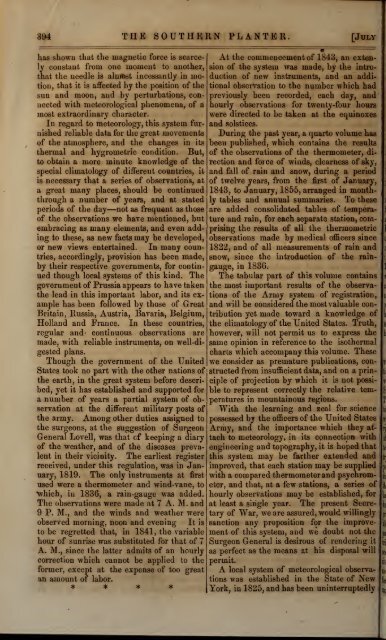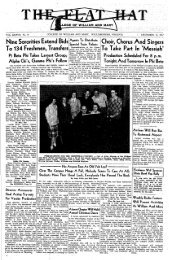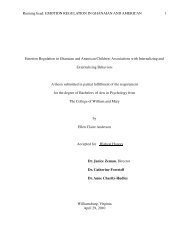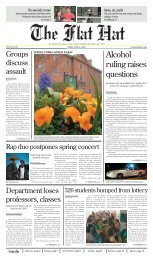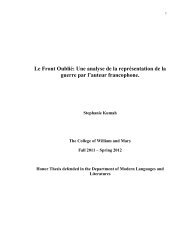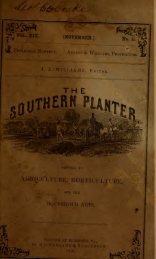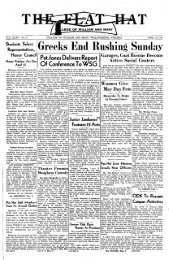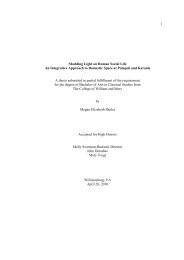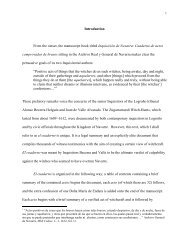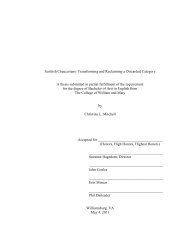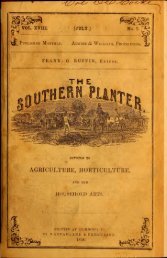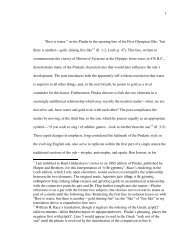Southern planter - The W&M Digital Archive
Southern planter - The W&M Digital Archive
Southern planter - The W&M Digital Archive
You also want an ePaper? Increase the reach of your titles
YUMPU automatically turns print PDFs into web optimized ePapers that Google loves.
394 THE SOUTHERN PLANTER. [July<br />
has shown that the magnetic force is scarce-<br />
ly constant from one moment to another,<br />
that the needle is almost incessantly in motion,<br />
that it is affected by the position of the<br />
sun and moon, and by perturbations, connected<br />
with meteorological phenomena, of a<br />
most extraordinary character.<br />
In regard to meteorology, this system furnished<br />
reliable data for the great movements<br />
of the atmosphere, and the changes in its<br />
thermal and hygrometric condition. But,<br />
to obtain a more minute knowledge of the<br />
special climatology of different countries, it<br />
is necessary that a series of observations, at<br />
a great many places, should be continued<br />
through a number of years, and at stated<br />
periods of the day—not as frequent as those<br />
of the observations we have mentioned, but<br />
embracing as many elements, and even adding<br />
to these, as new facts may be developed,<br />
or new views entertained. In many countries,<br />
accordingly, provision has been made,<br />
by their respective governments, for continued<br />
though local systems of this kind. <strong>The</strong><br />
government of Prussia appears to have taken<br />
the lead in this important labor, and its example<br />
has been followed by those of Great<br />
Britain, Russia, Austria, Bavaria, Belgium,<br />
Holland and France. In these countries,<br />
regular and' continuous observations are<br />
made, with reliable instruments, on well-digested<br />
plans.<br />
Though the government of the United<br />
States took no part with the other nations of<br />
the earth, in the great system before descri-<br />
bed, yet it has established and supported for<br />
a number of years a partial system of ob-<br />
servation at the different military posts of<br />
the army. Among other duties assigned to<br />
the surgeons, at the suggestion of Surgeon<br />
General Lovell, was that cf keeping a diary<br />
of the weather, and of the diseases preva-<br />
lent in their vicinity. <strong>The</strong> earliest register<br />
received, under this regulation, was in Jan-<br />
uary, 1819. <strong>The</strong> only instruments at first<br />
used were a thermometer and wind-vane, to<br />
"which, in 1836, a rain-gauge was added.<br />
<strong>The</strong> observations were made at 7 A. M. and<br />
9 P. M., and the winds and weather were<br />
observed morning, noon and evening It is<br />
to be regretted that, in 1841, the variable<br />
hour of sunrise was substituted for that of 7<br />
A. M., since Ihe latter admits of an hourly<br />
correction which cannot be applied to the<br />
former, except at the expense of too great<br />
an amount of labor.<br />
At the commencement of 1843, an exten-<br />
sion of the system was made, by the intro-<br />
duction of new instruments, and an additional<br />
observation to the number which had<br />
previously been recorded, each day, and<br />
hourly observations for twenty-four hours<br />
were directed to be taken at the equinoxes<br />
and solstices.<br />
During the past year, a quarto volume has<br />
been published, which contains the results<br />
of the observations of the thermometer, di-<br />
rection and force of winds, clearness of sky,<br />
and fall of rain and snow, during a period<br />
of twelve years, from the first of January,<br />
1843, to January, 1855, arranged in month-<br />
ly tables and annual summaries. To these<br />
are added consolidated tables of temperature<br />
and rain, for each separate station, comprising<br />
the results of all the thermometric<br />
observations made by medical officers since<br />
1822, and of all measurements of rain and<br />
snow, since the introduction of the raingauge,<br />
in 1836.<br />
<strong>The</strong> tabular part of this volume contains<br />
the most important results of the observa-<br />
tions of the Army system of registration,<br />
and will be considered the most valuable con-<br />
tribution yet made toward a knowledge of<br />
the climatology of the United States. Truth,<br />
however, will not permit us to express the<br />
same opinion in reference to the isothermal<br />
charts which accompany this volume. <strong>The</strong>se<br />
we consider as premature publications, constructed<br />
from insufficient data, and on a prin-<br />
ciple of projection by which it is not possible<br />
to represent correctly the relative tem-<br />
peratures in mountainous regions.<br />
With the learning and zeal for science<br />
possessed by the officers of the United States<br />
Army, and the importance which they attach<br />
to meteorology, in its connection with<br />
engineering and topography, it is hoped that<br />
this system may be farther extended and<br />
improved, that each station may be supplied<br />
with a compared thermometer and psychrometer,<br />
and that, at a few stations, a series of<br />
hourly observations may be established, for<br />
at least a single year. <strong>The</strong> present Secre-<br />
tary of War, we are assured, would willingly<br />
sanction any proposition for the improvement<br />
of this system, and we doubt not the<br />
Surgeon General is desirous of rendering it<br />
as perfect as the means at his disposal will<br />
permit.<br />
A local system of meteorological observations<br />
was established in the State of New<br />
York, in 1825, and has been uninterruptedly


